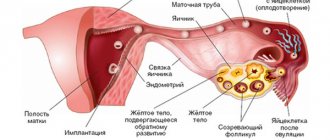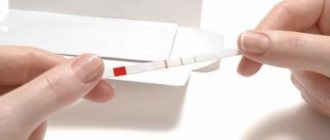Unfortunately, not all women can experience the joy of motherhood without seeking help from doctors. To get pregnant, some of them need to undergo complex and sometimes expensive procedures, including IVF (in vitro fertilization). During it, an egg artificially fertilized in the laboratory is transplanted into the uterine cavity and, naturally, the introduction of a foreign element causes a certain reaction in the body. In some cases, the embryo takes root normally, and sometimes not. And a very important indicator of a successful procedure is discharge after IVF. And a woman needs to constantly monitor their character. After all, if the body begins to reject the egg, they immediately change, which requires an immediate visit to the doctor, otherwise pregnancy will never occur.
How to determine that fertilization was successful?
There are several signs that indicate this. Placement of the embryo into the uterus artificially begins on the third day after successful fertilization in the laboratory.
During normal pregnancy, the body begins to produce all the necessary hormones on its own. They give a successful start to the fetus. For this, doctors prepare the patient by prescribing courses of hormonal therapy. This greatly increases her chances.
After completing and checking the quality of this preparation, the fetus is attached to any wall of the uterus within 7 days. Pink or brown discharge will indicate success. This will mean that the embryo has taken root in the body and is not in danger.
The implantation period will take up to two days. Accompanied by discharge of red or brown fluid. That is, there is no need to panic and run to the doctor. This is all within the normal range and normal reaction of the body.
On the 12th day, after a successfully completed operation, the expectant mother will begin to:
- Minor pain in the lower abdomen with a pulling effect.
- Common weakness.
- Iron smell and taste in the mouth.
- Nervousness caused by almost nothing.
- Change of taste.
Read: Up to what age can IVF be done for free and for a fee?
But in the first days, after a successful embryo transfer, a completely different situation will begin. In the first six days, the general condition will remain unchanged. The discharge will be clear, watery, thin or mucous. Without any odor or irritation in the bikini area. The only change at this stage will be their abundance.
On the seventh day, their chemical composition will begin to change. They will become thicker and look like regular cream. Their color rarely changes from transparent to white. Don't worry about this.
Recommendations
Implantation occurs on the 7th day of completion of the procedure. Consequently, both its symptoms and pregnancy occur only after the expiration of this period of time. Therefore, if there is no discharge after embryo transfer, this is not bad.
Remember that the period after embryo transfer is very important. The success of IVF largely depends on the woman’s behavior in the first days after the procedure. Therefore, you should pay attention to all changes in the body so as not to miss the possible appearance of threatening symptoms. If they occur, immediate medical attention is required.
Upon completion of the procedure, observe the following rules:
- bed rest for 24 hours after embryo transfer;
- do not take a bath or shower on the first day after the procedure;
- abstain from sexual activity until pregnancy is confirmed;
- limit physical activity and heavy lifting;
- protect the body from hypothermia and infectious diseases;
- do not use tampons.
If there are any obvious changes, if they bother you, you should tell your doctor. He will conduct an examination and identify the causes of such signs. Then he will be able to determine how dangerous everything is and how to avoid a health threat.
The significance of IVF is that a woman with such a pregnancy receives a gift, as well as difficult work. You should not self-medicate; it is recommended to carefully monitor your body.
After the IVF procedure, doctors urge women to be especially attentive to their well-being, because we are talking not only about the patient’s health, but also about the successful implantation of the embryo. Therefore, you should pay attention to absolutely all the signs. In particular, one of the most important is discharge after embryo transfer.
Why did the color turn brown?
For the first two weeks this is quite normal. At a later date, you need to consult a doctor. In general, this color means that the female body did not tolerate the procedure well. The vaginal uterus itself was not prepared properly. After a two-week period, these are the first signals of a miscarriage.
In the eighth or tenth week of pregnancy, this color means placental abruption. And this is a step towards fetal death or developmental disorders. The general indicator of well-being will become worse. Abdominal pain will appear. To level out the situation, you will have to undergo a course of treatment in a hospital.
A little theory
Introduction of fertilized egg into the uterus
called implantation. The embryonic villi penetrate the lining of the uterus, which may cause minor bleeding.
In order for implantation to be successful, several conditions must be met:
- lush three-layer endometrium with a high content of substances that nourish the embryo;
- high amount of progesterone in the body (so that the embryo can develop and menstruation does not begin);
- normal microflora in the body.
The process of fertilization and development of the fertilized egg
- not instantaneous. And each stage is important for the onset of a normal pregnancy and the formation of a healthy fetus.
Bloody discharge
Typically, such a secretion, reminiscent of menstruation, appears when the fetus transferred into the uterine cavity was previously frozen. This is called cryotransfer. Their ability to survive is extremely low. Therefore, they very rarely take root. Because of this, blood discharge from the vagina occurs. It is the female body that rejects the frozen egg. All action occurs within three to five days after transplantation.
Other such discharges indicate:
- Frozen pregnancy.
- Severe hormonal disorder in the body.
- Decreased readings of the hormone progesterone.
Any discharge of this nature should alert every girl. Even if in very small quantities and rare cases. All this can increase in the general indicator of any serious chronic diseases and pathologies. To become a happy mother, she needs to tolerate the entire procedure well, without any complications. Therefore, you need to contact specialists for any changes.
Forecast
Brown discharge after embryo transfer can be a good or bad prognostic sign of pregnancy development after IVF. If they appear, you should take action and inform your doctor. The outcome of IVF depends on the timeliness of the measures taken.
After the embryo transfer is completed, the woman begins to prepare for pregnancy, she hopes that implantation will be successful. But not everything ends well; in some cases, bleeding may occur in the first week after embryo transfer. This is a situation in which a woman who decides to undergo IVF should understand at least a little.
What other secretions can accompany artificial insemination?
Before immediate transplantation, five-day therapy is prescribed. It includes hormonal drugs. They should provoke the growth of an egg on the ovaries. Medical devices are used to select them. Before use, they must be cleaned of germs and other bacteria.
Read: What methods are effective for having twins?
This happens rarely, but the human factor is impossible to predict. In practice, this will result in genital infections. This is where yellow or green discharge will appear, with a very nasty odor. There will be severe discomfort in the perineum.
In some cases, an exacerbation of the thrush disease begins. Then a cheesy mass will begin to flow out of the vagina. The smell will become sour and very unpleasant. There will be a strong itching sensation.
Treatment consists of medications with antifungal and antibacterial effects. This needs to be done before IVF. Otherwise, any infection will enter the uterus and kill the embryo.
Causes
After hormonal preparation, it is simply impossible to say with certainty whether there will be disturbances in the cycle. The human body is unpredictable and very complex; any attempts to interfere with the regulation of its basic processes are not without consequences.
It happens that there is bleeding after transfer - this may be a symptom of the embryo attaching to the uterus or its rejection. The embryo may be rejected by the body for various reasons, for example, the embryo may be weak. With the help of bleeding, a woman’s body cleanses the uterine cavity. Such situations can also occur during natural pregnancy.
This is how the embryo damages the uterine wall during the implantation process. After injury, slight bleeding may begin.
For example, the well-known toxicosis begins due to the fact that the woman’s immune system perceives the fetus as a foreign body.
It may also bleed after transfer. The embryo attaches to the uterus and the mother's circulatory system, partially damaging the surface layer of the uterus. Starts to bleed. Therefore, it is very important to do an hCG test, which will definitively show whether there is pregnancy or not. If the hCG is low, then implantation has not occurred (the embryo has not taken root).
If a literal drop of blood was found immediately after the transfer procedure, there may have been a minor injury during the transfer. This happens during a difficult transfer.
Reasons for difficult transfer:
- Blood after the transfer may be caused by uterine contractions during the transfer process.
- It happens that during replanting the cervical canal is damaged.
- Sometimes there is a bend between the cervix and its body.
- Very low qualifications of the doctor (low experience).
Therefore, if the transfer was difficult, the woman may notice small light beige discharge for 2 days after replantation.
Sometimes it happens that discharge after the procedure is caused due to the onset of complications of the disease. For example, these could be polyps in the uterus, infection, oncology, cervical erosion, or chronic diseases not identified during the preparation for IVF.
What discharge is considered normal after IVF?
Some discharges occur due to various physiological factors. The main thing to understand is that if their indicators do not exceed the acceptable characteristics, then you should not panic. Such factors may include maintaining the level of acidity, normalizing humidity, and different reactions to different drugs.
In almost 40% of cases, the situation involves the use of medications with progesterone. This is necessary to support the female body. They come in the form of gels. When used, the gel-forming particles are mixed with vaginal secretions. When flowing out, they will have slightly strange properties, namely:
- The color will turn yellow.
- The consistency will vary in composition, and the separation will be accompanied by veins.
- Complete absence of any odors.
- Average amount of discharge.
Timing of implantation
After ovulation
and the meeting of the egg with the sperm, the fertilized zygote begins to move through the fallopian tubes.
Its task is to get into the uterus as quickly as possible in order to gain a foothold in the endometrium specially prepared for this. Along the way, the zygote continuously divides and grows.
occurs at the blastocyte
Conventionally, we can distinguish between middle, late and early implantation.
- Early. It is quite rare. Usually, implantation that occurs 6-7 days after ovulation is considered early (or 3 dpp - 4 dpp
if we are talking about IVF) - Average. 7-10 days pass between fertilization and implantation ( implantation of the embryo after transfer
occurs approximately 4-5 days).
Doctors say that it takes about 40 hours for morula to penetrate, after which the body begins to produce the hormone hCG in the blood, and the basal temperature
. Based on this, the so-called embryonic period of development, which lasts until approximately 8 weeks of pregnancy. - Late. Occurs approximately 10 days after fertilization. This is what always gives women at least a faint hope of a possible pregnancy - even when you can hardly expect it anymore.
If pregnancy does not occur for a long time, then you need to be examined to identify the cause of infertility.
In Vitro Fertilization
This is a difficult and serious procedure. A positive effect is not always achieved. One of the main signs is the appearance of bloody discharge. Gradually they will become more profuse and bleeding will begin with unbearable pain in the lower abdomen.
Read: Eco pregnancy test
First of all, you need to consult a gynecologist or embryologist. This situation indicates poor implantation of the fetus or the presence of serious, chronic diseases that are beginning to worsen. All this will begin after completing a course of hormonal drugs.
Frequent complications after such a procedure will be:
- Stillbirth. Miscarriage happens in the early stages. Fourth or sixth week of embryonic development. The girl will experience multiple discharges with blood, severe spasms in the groin area and increased fatigue.
- Frozen or ectopic pregnancy. Both pathologies occur with bloody vaginal secretions. To avoid this, the patient is admitted to the hospital for several weeks in order to detect and prescribe treatment in time, if necessary.
- Ovarian hyperstimulation syndrome. The most common symptom that appears after IVF. It begins even during the hormonal course. The resulting complications are accompanied not only by normal discharge with blood, but also by the formation of water in the ovarian area. Vomiting and uncontrolled diarrhea also occur with equal frequency. At the first signs, treatment should be started. The consequences will be infertility and the impossibility of repeating in vitro fertilization.
- Torsion of the ovaries. A condition that occurs after the retrieval of a finished egg. It is very dangerous due to its complications. It begins with enlarging the appendage and wrapping its legs. The consequence will be the accumulation of fluid and the emergency development of necrotic processes.
To avoid all these complications and their consequences, every woman, before the procedure, must go through the entire preparatory process correctly and in the right order. To do this, the first step will be to completely abandon any bad habits. Next, find out all existing chronic diseases and genetic pathologies. Then, creating the right menu. Don't eliminate fatty foods, but stop adding hot spices.
When the embryo is placed in her uterus, you need to carefully monitor your well-being and not take rash actions. For any deviations, it is better to consult a doctor.
So, during artificial insemination, the discharge is different. This article will tell expectant mothers what decision to make in certain cases. Good luck!
Everything a woman needs to know after embryo transfer in the following video:
01 Jun 2021 Valeria 339
Share this post
We recommend reading along with this article
- Up to what age can IVF be done for free and for a fee?
- How pregnancy manifests itself in the early stages: signs before delay
- When do periods appear: first and after childbirth?
- Brown discharge in early pregnancy: causes and...
- Belly in early pregnancy: different sensations
- When can a woman become pregnant and is it possible to count the days in...
- Periods during pregnancy, is this possible?
- The problem of married couples - how to get pregnant accurately and quickly
- Preparation for 1st trimester screening and analysis of its results
Let's sum it up
Discharge after IVF of various natures accompanies pregnancy. They differ in color, smell, consistency and frequency of occurrence. It is important to remember that any deviation from normal discharge should become a beacon for the expectant mother. Self-diagnosis of the causes of certain phenomena, self-medication, and especially ignoring possible or obvious problems is prohibited! First of all, you should listen to your body and trust your maternal instinct. It’s better to play it safe and contact a specialist once again than to overlook it.
It remains to wish all future parents health, patience and happy children!
Advances in modern medical technology give hope to many women who cannot conceive naturally to become mothers. The help of doctors in this matter is simply invaluable. For successful conception to occur, both specialists and the patient herself need to make a lot of effort. Sometimes you have to perform a number of complex and by no means cheap procedures, following special techniques. One such technique that has successfully proven itself is in vitro fertilization (IVF). Its essence is the artificial implantation of an egg fertilized in a laboratory into the uterine cavity. The female body is not always able to accept this biological structure. In some cases, a reaction of its rejection as a foreign element develops. Therefore, not in all cases of the IVF procedure, its results are successful. The development of the embryo may proceed normally, or it may fail.
How successfully IVF was performed overall, and how reliably the implanted egg was able to attach itself, is assessed by several indicators. One of them is the nature of vaginal discharge after the procedure. If the egg begins to be rejected, the discharge changes in color and structure.
Well-being
When menstruation comes after unsuccessful IVF, a woman may feel unwell. Diarrhea, vomiting, dizziness, nausea, headache appear, the breasts become tender and swollen. There may be heavy bleeding. In this case, you cannot use hemostatic agents yourself; call an ambulance immediately. Heavy bleeding will lead to fainting and anemia. Painful periods after IVF should not be ignored.
In the next cycle after unsuccessful IVF, the sensations will be the same as during normal critical days. A slight increase in temperature is possible.
Sometimes doctors manage to maintain a pregnancy if the woman immediately sought help, started taking Tranexam, and her support was not canceled. If the application is late, bleeding will most likely mean that the artificial insemination procedure ended in a negative result.
We trust nature
Women re-read tons of literature, trying to find those 5 dpo sensations
or
6 dpp sensations
that would indicate implantation and, accordingly, the onset of pregnancy.
Actually, expectant mothers start worrying whether it worked or not at 3 DPO
.
This question is equally of concern to girls who have undergone the IVF procedure. Estimated embryo implantation after IVF
They try to catch it by minimal changes in the body and well-being.
The Internet is replete with requests like “ 5 dpp of three days
”, “
4 dpp of five days”
, “
7 dpp of five days
”, with the help of which women look for positive stories.
The absence of even a hint of a second page on day 8
or
menstruation after embryo transfer
.
But in fact, the answer to the question of why the embryo does not take root
may be an objective situation of natural selection. The non-viable fetus was rejected, giving way to healthy offspring.
In fairness, it is worth noting that if such rejection is repeated constantly, then this is a reason for a full medical examination. The reason for the failure of a long-awaited pregnancy may be male infertility.
Implantation is a critical point, because the blastocyte is perceived by the woman’s body as a foreign object due to the presence of male genes in the cell. The speedy and successful introduction into the endometrium and the onset of a normal healthy pregnancy depend on how well the defense mechanisms of this cell work.
During IVF, a woman’s body undergoes changes not foreseen by nature due to the intake of hormonal drugs. This is necessary to prepare the endometrium so that the implanted embryo attaches to the wall of the uterus and begins to develop.
For these purposes, patients are prescribed the administration of the hormones progesterone and estradiol. Let's look at what happens to the uterus in the natural menstrual cycle and what bloody discharge after IVF indicates.
The endometrium is the inner layer of the uterus, subject to constant cyclic changes under the influence of sex hormones. During the menstrual cycle (MC), the functional layer is rejected, restored, expanded and secreted.
The recovery and growth phase occurs in the first half of the MC (starting from the fifth day) under the influence of estrogens and small doses of progesterone; it corresponds to the follicular phase of the ovaries. The secretion phase corresponds to the luteal phase of the ovaries, occurs under the influence of progesterone and estrogens, and occupies the second half of the menstrual cycle (from ovulation to menstruation).
The highest secretion activity is on days 20-22 (days 6-8 after ovulation), if the cycle is 28 days. At this time, changes occur in the blood vessels - the arteries twist, the veins expand, and the cells of the mucous membrane are filled with nutrients. The endometrium is ready for implantation; this is the most favorable time for it.
Starting from days 24 to 27, conditions for implantation worsen - endometrial nutrition decreases, capillaries dilate, and minor hemorrhages appear. Due to the fading of the corpus luteum and a drop in the level of sex hormones, oxygen starvation of the inner layer of the uterus occurs.
The arteries spasm, become brittle, blood circulation is disrupted, hemorrhages and blood clots form. After this, dilation of blood vessels occurs, increased blood flow leads to their rupture and rejection of the mucous layer, which is manifested by menstrual bleeding.
With IVF
More often, spotting occurs 8-9 days after embryo transfer during IVF. This process should not cause panic, everything is quite understandable. During IVF, inadequate changes in the endometrium occur under the influence of large doses of externally administered hormones.
The tone of the uterus increases, blood vessels and the entire coagulation system undergo more pronounced changes under the influence of superload. This may be one of the reasons for discharge after embryo transfer during IVF.
Thus, the non-physiological effect of hormones on the endometrium in IVF cycles can lead to inadequate proliferation and secretion of the endometrium, its greater friability and trauma; this process is also influenced by the degree of susceptibility of the receptors of the functional layer of the uterus to sex hormones.
Discharge after IVF can be brown, spotting, or copious, bloody - pink. Bright scarlet discharge should alert the woman and the gynecologist due to the risk of bleeding.
The hormonal load during the protocol affects the blood coagulation system, which can malfunction and lead to heavy bleeding after embryo transfer.










